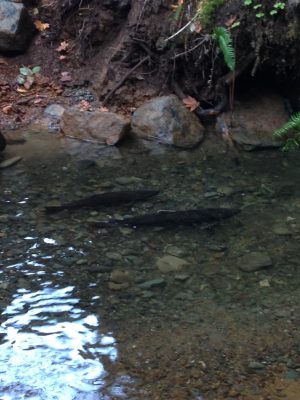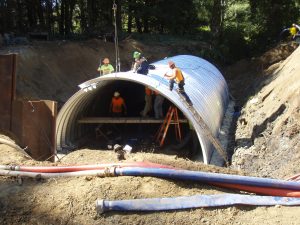www.ChehalisLeadEntity.org
News

Stream restoration projects in the Chehalis Basin provide jobs, learning opportunities, and new habitat for salmon
Stream restoration projects in the Chehalis Basin provide jobs, learning opportunities, and new habitat for salmon
January 25, 2017
Twenty-three on-the-ground restoration projects that protect and restore valuable habitat for salmon are well underway throughout the Chehalis River Basin in Thurston, Lewis and Grays Harbor Counties. Implementing these projects is bringing nearly $6 million to basin communities through local restoration and construction jobs.
 Most of the projects restored fish access to habitat that was blocked by culverts or other structures. Altogether, the projects have opened up 130 miles of stream habitat for migrating salmon. Some projects improved culverts on county and private roads, which will have the added benefit of reduced flooding of transportation corridors.
Most of the projects restored fish access to habitat that was blocked by culverts or other structures. Altogether, the projects have opened up 130 miles of stream habitat for migrating salmon. Some projects improved culverts on county and private roads, which will have the added benefit of reduced flooding of transportation corridors.
Eight culvert correction projects completed by the Lewis County Conservation District have fully opened up 68 miles of stream to migrating juvenile and adult coho, steelhead and cutthroat. One barrier correction project alone improved fish passage for 47 miles of stream in the Lincoln Creek basin. “The contracts to do this work went out to four contracting companies, resulting in work for about ten people this past summer,” said Conservation District manager Bob Amrine.
In Thurston County, the Darlin Creek culvert removal project led by Capitol Land Trust, opened up habitat for coho and cutthroat in a high conservation priority area of the Black River watershed. A project spearheaded by the Sylvan Terrace Homeowners’ Association also corrected a fish passage barrier near Black Lake. The Association chose to use the project as an educational opportunity, so invited a Boy Scout Troop 007 from Lacey to learn about the wildlife on the site and to plant willow stakes on the creek’s edge. During the work party, one Scout noted: “This is hard work, but it’s fun!”

John’s River project underway
Ten projects have been funded in the lower watershed in Grays Harbor County, under the management of the Chehalis Basin Fisheries Task Force. Completed projects have led to immediate benefits for fish. Adult coho and chum salmon were observed spawning at Atwood Creek on Johns River, and at Big Creek, a tributary to the Humptulips River. At a project site near Porter, project manager Lonnie Crumley reported that construction workers observed juvenile coho moving upstream of the new culvert installation as soon as the stream was allowed to pass through it. “This made the contractors ‘believers’ since they saw the projects they were doing are actually allowing fish to immediately move upstream to new habitat that has been blocked for decades,” Crumley added. The six culvert corrections completed this summer opened more than 30 miles of stream habitat for salmon spawning and rearing and employed more than 37 construction workers in the Lower Chehalis Basin and Grays Harbor County. Dozens of other support jobs such as gravel and material supply businesses benefited from these fish barrier correction projects as well.
In addition to these and other fish barrier correction projects that have immediate benefits, three projects are underway that will lead to future restoration actions. Funds are supporting restoration design on the lower Satsop River floodplain, project development on eleven additional sites in Grays Harbor County, and identification of restoration projects in the Newaukum River and its tributaries. All of the projects will lead to improvement of the habitats that sustain fish populations over the long term.
The projects represent an initial phase of a long-term effort to restore river habitat and reduce flood damage throughout the basin. State lawmakers included the grant funds in the 2015-17 capital budget as part of a $50 million appropriation for the overall initiative.
** ** **
To get involved in local salmon recovery efforts, visit the Chehalis Lead Entity’s website: www.chehalisleadentity.org.
To learn more about the State’s strategy around flood damage reduction and habitat improvement, visit the Chehalis Strategy website: www.chehalisbasinstrategy.com.